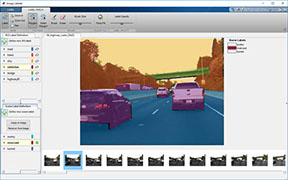Getting Started with Semantic Segmentation Using Deep Learning
Segmentation is essential for image analysis tasks.Semantic segmentationdescribes the process of associating each pixel of an image with a class label, (such asflower,person,road,sky,ocean, orcar).

Applications for semantic segmentation include:
Autonomous driving
Industrial inspection
Classification of terrain visible in satellite imagery
Medical imaging analysis
Train a Semantic Segmentation Network
The steps for training a semantic segmentation network are as follows:
1.Analyze Training Data for Semantic Segmentation
2.Create a Semantic Segmentation Network
Label Training Data for Semantic Segmentation
Large datasets enable faster and more accurate mapping to a particular input (or input aspect). Using data augmentation provides a means of leveraging limited datasets for training. Minor changes, such as translation, cropping, or transforming an image provides new distinct and unique images. SeeAugment Images for Deep Learning Workflows Using Image Processing Toolbox(Deep Learning Toolbox)
You can use theImage Labelerapp to interactively label pixels and export the label data for training. The app can also be used to label rectangular regions of interest (ROIs) and scene labels for image classification.

See Also
Apps
Functions
evaluateSemanticSegmentation|fcnLayers|pixelLabelDatastore|segnetLayers|semanticseg|semanticSegmentationMetrics|unet3dLayers|unetLayers
Objects
Related Examples
- Augment Pixel Labels for Semantic Segmentation(Deep Learning Toolbox)
- Import Pixel Labeled Dataset For Semantic Segmentation
- Semantic Segmentation Using Deep Learning
- Label Pixels for Semantic Segmentation
- Define Custom Pixel Classification Layer with Tversky Loss
- Semantic Segmentation Using Dilated Convolutions
- Calculate Segmentation Metrics in Block-Based Workflow
More About
- Deep Learning in MATLAB(Deep Learning Toolbox)

